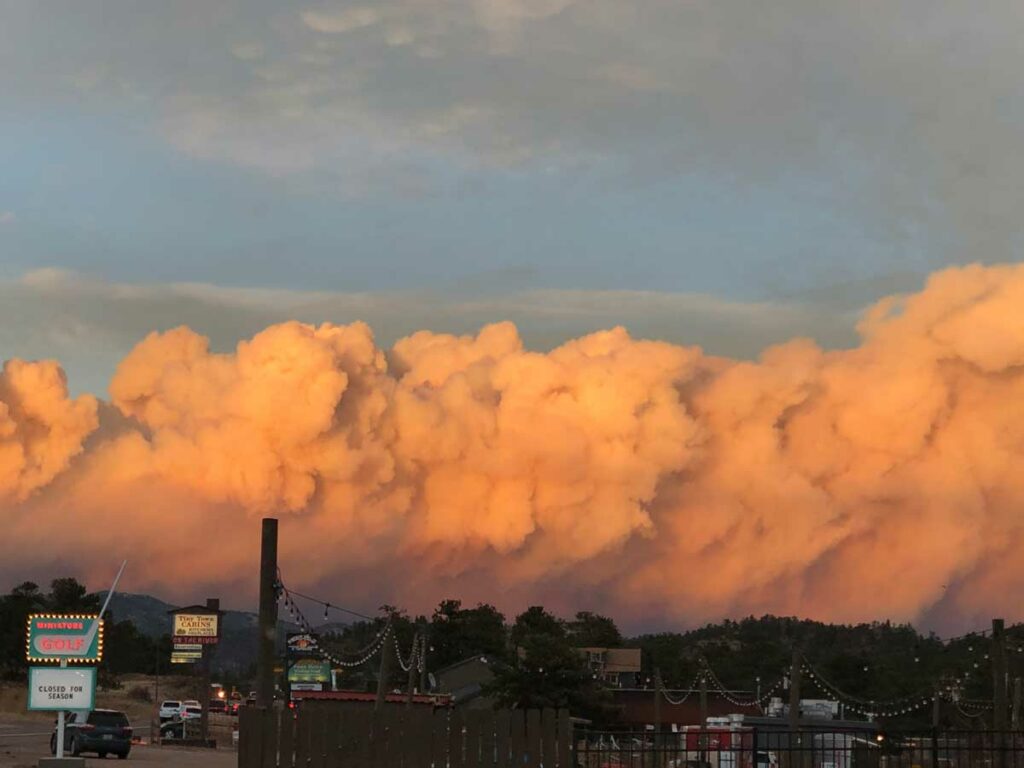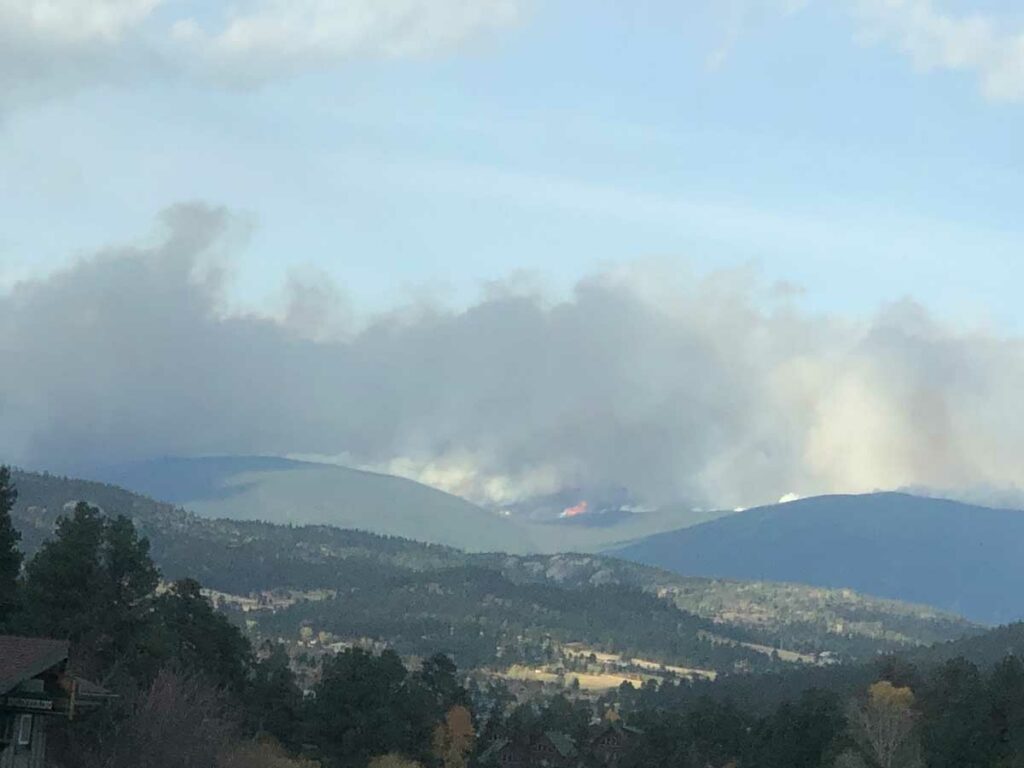How Fire Departments Can Secure Grant Funding for Their Wildfire Operations

In October of 2020, I was on vacation in Estes Park, Colorado with my husband. Our intention was to visit Rocky Mountain National Park and explore the beautiful surroundings in the crisp fall weather. However, one of the largest wildfires in Colorado history was raging right outside the town. A giant cloud of smoke blocked out the sun as we approached the area; it was possible to see the red glow on a mountain peak not far from the Stanley Hotel where we were staying. We were safe during our three days in Estes Park, but the town was evacuated and all gates to the park were closed shortly after we left for our next stop, Steamboat Springs, Colorado. A fire was burning there as well. The mountain ridges were burning everywhere we went.
Record Breaking Devastation
The fires we saw raging were the East Troublesome1 and the Cameron Peak2 fires. They are respectively classified as the fastest-moving and largest fires in Colorado history. These fires destroyed more than 300,000 acres of land and more than 800 structures, killed two people, and forced the evacuation of numerous towns. The hard work of hundreds of wildland firefighters in multiple incident command teams ensured more lives and property were not lost. The new COVID-19 pandemic made it even more complicated and expensive for all involved.
Hot Shots
Many of us are aware of funding sources for urban or structural firefighting, but that is only one type of firefighting. The U.S. Forest Service alone has more than 10,000 professional firefighters, “Hot Shots,” who respond to fires on land under their jurisdiction3 such as national parks. There are many departments across the country that are not part of the federal system but also provide wildland firefighting services—either as their primary function or because they operate on a Wildland Urban Interface (WUI)4, a zone where a community’s structures border an unpopulated area. How is it possible to get the funding needed to support these departments’ wildland firefighting needs?
Federal Resources
The federal government provides the lion’s share of resources for wildland firefighting. The government departments that are involved in assisting departments are the U.S. Department of Agriculture, the U.S. Department of the Interior, Federal Emergency Management Agency (FEMA), and the U.S. General Services Administration. It is also possible to see information from the Bureau of Land Management, which is an agency within the Department of the Interior. Other agencies such as the National Park Service, the U.S. Fish and Wildlife Service, and the Bureau of Indian Affairs are part of the Department of the Interior as well. It is important to recognize the names of these organizations and how they are structured within the Federal government so that grant writers can find funding opportunities as they arise. For example, the U.S. Fish and Wildlife Service offers a $20,000 grant to community fire departments in close proximity “to enhance local wildfire protection, purchase equipment, and train volunteer firefighters.”5 This grant is called the Rural Fire Assistance Program and is intended for large community departments that respond to assist the U.S. Fish and Wildlife Service on a regular basis. The grant is available for both career and volunteer departments.

Opportunities for funding are also available through FEMA. The Assistance for Firefighters Grant (AFG) and the Fire Management Assistance Grant (FMAG) provide funding to departments with coordination through the state’s Department of Emergency Management. The AFG can provide equipment, gear, vehicles, and funding for training opportunities. The FMAG is applied for once a wildland fire threat has already been declared. This grant operates on a 75-percent/25-percent cost share basis. The funds can be used for field camps, tools and tool replacement, and mobilization activities7. All federal grants require that the applicant department have a DUNS number. DUNS numbers can be obtained free of charge by phone ( 1-800-333-0505) or online (https://www.dnb.com/product/eupdate/requestOptions.html). Be sure to check with your state Department of Emergency Management prior to applying for a new number. It is likely your department has already been issued one.
State Resources
There are other grant opportunities available through state agencies in coordination with federal departments. The U.S. Forest Service, a department within the U.S. Department of Agriculture, has a program called the Federal Excess Personal Property Program (FEPP)6. The FEPP loans equipment to individual states who can then place the equipment with local departments. The equipment on loan can be anything from vehicles to items like turnout gear and generators. There is also a similar program called the Federal Firefighter Property Program (FFP). This program is also administered through the U.S. Forest Service and the Department of Agriculture. It allows departments to request needed items through their state Department of Forestry. These items are donated by the Department of Defense and do not need to be returned. In order to apply for FEPP and FFP assistance, the department representative will need to apply for a Federal Excess Property Management Information System (FEPMIS) account. There are training modules on the FEPP website that will give step by step guidance in how to accomplish this. Be sure to check with your state Department of Forestry for specific guidance prior to requesting an account or items. There is also a National FEPP/FFP Program Manager who can be contacted if needed.
State agencies may also offer grant resources specific to the needs of the communities based on their geography and infrastructure. For example, the Virginia Department of Fire Programs and the Virginia Department of Forestry offer a Dry Hydrant Grant Program. This grant provides 100-percent funding for the installation and repair of dry hydrants to support firefighting operations. Dry hydrants can be an invaluable source of water for firefighting operations in no water zones. Be sure to check out these types of state and community specific grants in your area!
The wildland urban interface is only getting larger and the need for well-trained and well-equipped wildland firefighters grows every year. I saw only a brief glimpse of the devastation that tore through Colorado in October 2020. Many of you may see it every day you go to work. Mother Nature clearly can’t be stopped. Use these grants to ensure your department has the resources to keep your community as safe as possible!
END NOTES
1https://coloradoencyclopedia.org/article/east-troublesome-fire
2https://inciweb.nwcg.gov/incident/6964/
3https://www.fs.usda.gov/science-technology/fire/people
4https://www.usfa.fema.gov/wui/
5https://www.fws.gov/fire/living_with_fire/rural_fire_assistance.shtml
6https://www.fs.usda.gov/managing-land/fire/fepp
7https://www.fema.gov/assistance/public/fire-management-assistance

Mandy George is a retired lieutenant in the Chesapeake (VA) Fire Department. She has a master’s degree in emergency and disaster management, a master’s degree in professional writing, and an associate’s degree in emergency medical services. She is also a Nationally Registered Paramedic (NRP) and a Virginia Office of Emergency Medical Services (VAOEMS) Education Coordinator.
MORE MANDY GEORGE
ISFSI and Fire Grant Peer Review
Conference and Education Grants
How the Peer Review and Subject Matter Expert Evaluation Process Can Make You a Better Grant Writer
The New COVID-19 Grant Environment

